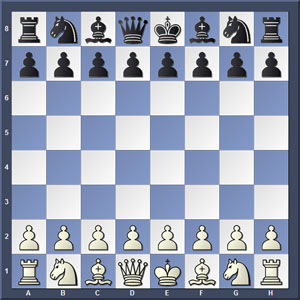Chess Notation - Keeping Score
Chess Notation
Keeping Score with
Algebraic Chess Notation
by Chess Instructor Dan Heisman
Advantages of scorekeeping include: 1) Replay your games to show better players and learn from your mistakes, 2) Re-set positions after illegal move sequences, 3) Prove who is to move and what the position is, and 4) Claim three-fold repetition and many other rules that require scoresheet proof. To keep score:
1. Each line of squares going up and down the board is called a “file”. For example, at the start of the game, both Kings are on the same file. Files are lettered with small letters: a, b, c, d, e, f, g, h. No matter what color you play, the “a” file is always on White’s left and Black’s right! The Kings are on the “e-file.”

2. Each line of squares going left to right across the board is called a “rank”. For example, at the start of the game, all your pawns are on the same rank. Ranks are numbered 1, 2, 3, 4, 5, 6, 7, 8. The first rank is always where White sets up his major pieces; the eighth rank is where Black sets up his major pieces. No matter what color you play, the rank in front of Black is always #8!
3. Each square is identified by its file and rank. So at the start of a game White sets up his King on e1 and Black sets up his King on e8.
4. Each piece has a capital letter associated with its name. The King = K; Knight = N; Queen = Q; Rook = R; Bishop = B. There are so many pawns that no letter is used for a pawn (see example in #5 below).
5. Every time you move, you write the letter for the piece that moved followed by the name of the square it moved to. For example, Ke2 or Qh5 or Bh8 or Nf6. No dashes; it’s that easy. For pawn moves you don’t write the “p”, just the destination square: e4, e5, h8. Remember: Capital letters are pieces, small letters files
6. If more than one piece of the type that moved can move to the same destination square, put the name of the rank or file where the piece came from after the piece name to make the move unique: Rae1 or N8d7.
7. When you capture with a piece, put an “x” between the name of the piece and capture square: Kxe2, Qxh5.
8. When you capture something with a pawn, instead of putting the name of the piece on the left, you put the file (not the square) it came from, then the x and the square on which it captured. For example: dxe5 or hxg6. Pawn captures are the most commonly misused part of keeping score, so practice this correctly.
9. When a pawn reaches the final rank, indicate the square and the promoted piece, separated by an "=" sign. For example, a8=Q or c1=N.
10. When you castle, you write 0-0 for Kingside, or 0-0-0 for Queenside castling - the number "0's" is equal to the num ber of squares the Rook moved!
11. A check is indicated by a plus at the end of the move: Rh8+ or Qxe2+.Mate can be “#” or “mate”
12. When using a blank page, write the move numbers first down the left side of the page (column form). Black’s moves are written to the right of White’s. Remember, both players have a first move. Each player writes down all the moves for him and his opponent. Both players should be writing the exact same thing, since the first rank is always in front of White and the eighth in front of Black. To best learn, keep score for 10+ games (half White and Black) over a short period of time. Tip: Write your move before you play it!
A sample famous game: 1.e4 e5 2.Nf3 d6 3.d4 Bg4 4.dxe5 Bxf3 5.Qxf3 dxe5 6.Bc4 Nf6 7.Qb3 Qe7 8.Nc3 c6 9.Bg5 b5 10.Nxb5 cxb5 11.Bxb5+ Nbd7 12.0-0-0 Rd8 13.Rxd7 Rxd7 14.Rd1 Qe6 15.Bxd7+ Nxd7 16.Qb8+!! Nxb8 17.Rd8#. This is not in column form due to lack of space.
National Master Dan Heisman is a highly acclaimed Chess Instructor and best selling chess author. You can get more terrific information about chess at Dan's Chess Page
Thank you for visiting our chess notation page. If you would like to make a comment on the information on chess notation, please email us at email@chesscentral.com.




